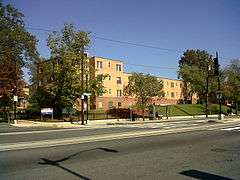Langston Terrace Dwellings
Langston Terrace Dwellings are historic structures located in the Langston portion of the Carver/Langston neighborhoods in the Northeast quadrant of Washington, D.C. The apartments were built between 1935 and 1938 and they were listed on the National Register of Historic Places in 1987.
Langston Terrace Dwellings | |
   | |
| Location | 21st St. N from Benning Rd. to H St., NE Washington, D.C. |
|---|---|
| Coordinates | 38°53′58″N 76°58′26″W |
| Built | 1935-1938 |
| Architect | Hilyard Robinson |
| Architectural style | International |
| NRHP reference No. | 87001851[1] |
| Added to NRHP | November 12, 1987 |
History

Langston Terrace was the first federally funded housing project in Washington and the second in the United States.[2] It was part of President Franklin Delano Roosevelt’s Public Works Administration and was named in honor of John Mercer Langston, a 19th-century American abolitionist and attorney who founded Howard University Law School, and served as a U.S. congressman from Virginia. The project cost the government $1.8 million and rooms were available for $6 per month or $4.50 per month without utilities.[3] The complex was designed by Bauhaus-trained Washington architect Hilyard Robinson in the International Style.[4]
The 274-unit complex was constructed primarily by African American laborers. The garden apartment buildings were built around common areas. Daniel Olney's The Progress of the Negro Race is a terra-cotta frieze in the central courtyard. It depicts African American history from slavery to World War I migration.[2] His Madonna and Children is located in the same courtyard. The animal sculptures also serve as climbing structures for children.
References
- "National Register Information System". National Register of Historic Places. National Park Service. March 13, 2009.
- "Langston Terrace Dwellings/Hilyard Robinson, African-American Heritage Trail". Cultural Tourism DC. Retrieved 2011-11-08.
- Fitzpatrick, Sandra; Goodwin, Maria R. (1990). The Guide to Black Washington. New York, New York: Hippocrene Books. pp. 77. ISBN 0870528327.
- "Langston Terrace Dwellings". DC Preservation. Archived from the original on 2011-07-01. Retrieved 2011-11-08.
- "10 Homes That Changed America". PBS. Retrieved July 31, 2018.
External links
| Wikimedia Commons has media related to Langston Terrace Dwellings. |